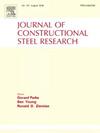Web-post buckling behaviour of composite beams with large elliptically-based web openings
IF 4
2区 工程技术
Q1 CONSTRUCTION & BUILDING TECHNOLOGY
引用次数: 0
Abstract
Steel beams with elliptically-based web openings have shown higher global shear resistance and increased flexural stiffness compared to those with circular web openings. However, the structural behaviour of steel-concrete composite beams with elliptically-based web openings has yet to be explored. This paper aims to investigate the web-post buckling resistance of steel-concrete composite beams with elliptically-based web openings since this failure mode has become more critical than the Vierendeel mechanism is such perforated beams. A high-fidelity finite element model was developed and a parametric study with 270 models was conducted based on key geometric parameters and various loading conditions. The influence of the geometric parameters of the elliptically-based web opening was examined, and the resistances were presented on bare steel (non-composite) perforated beams in line with previous findings. A previously developed model for predicting the web-post buckling resistance was assessed. The use of the buckling curve ‘c’, as specified by SCI P355 (2011), provided more effective results. However, buckling curve ‘α’ offers better accuracy for calculating the web-post buckling resistance in composite beams with elliptically-based web openings.
求助全文
约1分钟内获得全文
求助全文
来源期刊

Journal of Constructional Steel Research
工程技术-工程:土木
CiteScore
7.90
自引率
19.50%
发文量
550
审稿时长
46 days
期刊介绍:
The Journal of Constructional Steel Research provides an international forum for the presentation and discussion of the latest developments in structural steel research and their applications. It is aimed not only at researchers but also at those likely to be most affected by research results, i.e. designers and fabricators. Original papers of a high standard dealing with all aspects of steel research including theoretical and experimental research on elements, assemblages, connection and material properties are considered for publication.
 求助内容:
求助内容: 应助结果提醒方式:
应助结果提醒方式:


